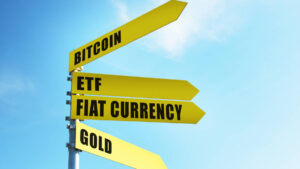Key trends in rapidly changing crypto world

Pic via Getty Images
From bitcoin’s deeper integration into traditional finance, AMP Super’s pioneering allocation being a standout example, to the Trump administration’s consideration of bitcoin as a strategic reserve asset, the crypto landscape is evolving at an unprecedented pace.
The crypto industry is poised for a year of significant transformation, driven by technological innovations, evolving market dynamics and growing institutional involvement.
Regulatory clarity will play a critical role in boosting market confidence and adoption, while innovations in DeFi (decentralised finance) and smart contracts continue to transform various industries. Additionally, the growing adoption of Web3 technologies – the next iteration of the internet and one that is built on blockchain technology and is communally controlled – will reshape ownership and governance models.
The convergence of artificial intelligence and blockchain, alongside the continued expansion of decentralised physical infrastructure network (DePIN), blockchain gaming, tokenisation of real-world assets (RWA), and the rise of utility tokens is shaping the industry’s future.
Monitoring global markets and regulatory developments will be crucial in navigating this rapidly evolving industry.
For currencies themselves, analysts forecast strong growth for leading cryptocurrencies, with bitcoin’s price potentially reaching $US120,000-$US200,000 and ethereum pushing towards $US10,000.
This growth will attract more institutional investment, diversify the market, and expand crypto adoption, creating new opportunities for asset exposure and innovation.
Key trends in 2025 include:
1. AI and AI agents
The convergence of AI and blockchain technology is unlocking new possibilities, from autonomous agents managing smart contracts to optimising trading strategies and enhancing customer experiences.
• NEAR Protocol (NEAR): A high-performance blockchain designed to seamlessly integrate with AI technologies. Its scalable and developer-friendly infrastructure enables the creation of AI-powered decentralised applications (dApps).
• Virtuals Protocol (VIRTUAL): A decentralised platform enabling the deployment of autonomous “agents” that can perform tasks such as optimisation and data analysis.
AI integration with crypto remains in its infancy, with numerous projects in experimental phases, paving the way for future advancements in efficiency and personalisation.
2. New opportunities
The combination of a DePIN infrastructure and blockchain technology is creating new opportunities, from enabling autonomous agents to managing complex tasks, to optimising operations and enhancing efficiency across various industries.
• Render Network (RENDER): Primarily known for its decentralised GPU rendering, RENDER’s infrastructure is being explored for high-demand computational tasks, including AI workloads that require significant processing power.
Emerging potential: The ability to create autonomous, decentralised networks powered by blockchain could reshape resource ownership and access, leading to greater innovation and growth in the crypto sector.
3. Blockchain gaming
The gaming industry continues to embrace blockchain technology, merging entertainment with economic opportunity through play-to-earn (P2E) and metaverse platforms.
• Immutable X (IMX): As a layer-2 ethereum scaling solution, Immutable X has become essential for gas-free NFT minting, enabling seamless integration of blockchain into gaming ecosystems.
Blockchain gaming is projected to grow exponentially in 2025, driven by advancements in scalability, NFT integration and increased adoption of decentralised gaming economies that offer real-world rewards.
4. RWA tokenisation
Tokenising traditional assets like real estate, intellectual property and commodities is unlocking liquidity, broadening market access and attracting growing institutional interest.
• Ondo Finance (ONDO): This platform is at the forefront of tokenising traditional financial products, including US treasury bonds, offering innovative yield opportunities within DeFi.
The RWA tokenisation market is expected to expand in 2025, as institutions explore blockchain’s ability to reduce barriers to investment, enable fractional ownership and enhance transparency in asset management.
5. DeFi innovation
Utility tokens play a pivotal role in DeFi, enabling lending, borrowing and seamless decentralised trading on blockchain-based platforms.
• Aave (AAVE): Empowers users to lend, borrow and earn interest on crypto without relying on intermediaries. It is a cornerstone of the DeFi ecosystem.
• Uniswap (UNI): Governs the Uniswap protocol, a leading decentralised exchange that facilitates peer-to-peer token swaps without intermediaries, driving liquidity and innovation in the DeFi sector.
The integration of RWA with DeFi protocols signals a transformative shift, unlocking new revenue streams, expanding market accessibility and encouraging institutional adoption of decentralised financial systems.
Many players and exchanges, such as BTC Markets, have been working to bridge the gap between innovation and accessibility. We introduced new tools, added more assets to our platform and enhanced our educational resources to ensure everyone, from first-time investors to seasoned traders, can engage confidently in this revolutionary space. Opportunities for growth, collaboration and innovation are boundless.
Caroline Bowler is CEO of Australian-based crypto exchange BTC Markets.
This article first appeared in The Australian.
Related Topics
UNLOCK INSIGHTS
Discover the untold stories of emerging ASX stocks.
Daily news and expert analysis, it's free to subscribe.
By proceeding, you confirm you understand that we handle personal information in accordance with our Privacy Policy.









In the past year, we’ve witnessed some transformative moments for cryptocurrency and blockchain technology.